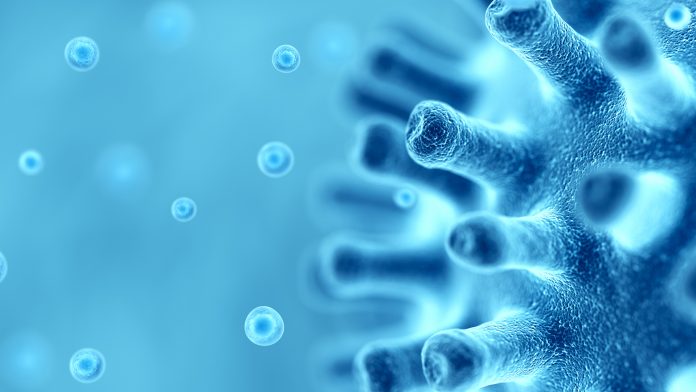Hokkaido University Assistant Professor Masaaki Kitajima and Ryo Iwamoto from Shionogi & Co Ltd are developing an innovative early warning and mass diagnosis system to fight against COVID-19 and future viral disease pandemics based on wastewater.
The ongoing global COVID-19 pandemic, which is caused by severe acute respiratory syndrome coronavirus 2 (SARS-CoV-2), has been declared to be a Public Health Emergency of International Concern by the World Health Organization. SARS-CoV-2 is a member of the Coronaviridae family, which consists of a group of enveloped viruses with a single-stranded RNA genome. These viruses cause diseases ranging from common colds to acute respiratory distress syndrome. Symptoms of SARS-CoV-2 infection include fever, myalgia, fatigue, and dry cough; and more than half of patients develop dyspnoea (shortness of breath).
Although the major transmission routes of SARS-CoV-2 are the inhalation of aerosols/droplets and person-to-person contact, there has been growing evidence of gastrointestinal symptoms caused by SARS-CoV-2 infections and the presence of viral RNA not only in faeces of infected individuals but also in wastewater.1 This suggests the need to better understand wastewater as potential sources of epidemiological data and human health risks.
Wastewater systems offer a practical approach to identifying viruses excreted in the faeces of an entire community (i.e., the population serviced by the wastewater system). Therefore, wastewater-based epidemiology (WBE) can be an effective tool for tracing the circulation of viruses in a community, providing the opportunity to estimate their prevalence and geographic distribution.
Traditional epidemiological approaches based on clinical diagnosis may be limited by the asymptomatic nature of viral infections and underdiagnosis of clinical cases, but the WBE approach enables the epidemiology of virus infections to be monitored, even if they are not evident via clinical surveillance. The asymptomatic infections of SARS-CoV-2 make it difficult to determine the actual degree of viral circulation in a community and it is also difficult for the data among diverse countries with different clinical diagnostic testing capacities to be compared.
Wastewater-based epidemiology could provide an unbiased method of evaluating the spread of infection in different areas, even before clinical testing is fully deployed in the population. It has been suggested that SARS-CoV-2 detection in wastewater could precede the first positive case in clinical testing. WBE can also be useful to determine when a new virus is introduced into a population or when fluctuations occur due to seasonal changes in disease prevalence.
Research outcomes from Hokkaido University
Dr Masaaki Kitajima et al. published the first peer-reviewed review paper on SARS-CoV-2 in wastewater1 in early 2020 and proposed that wastewater could provide a useful tool for monitoring COVID-19. The authors highlighted the need for further research to develop this as a viable method for tracking virus outbreaks. Their paper also argued that using wastewater to monitor COVID-19 offers several advantages over other methods, such as clinical testing, including the ability to detect both low levels of virus particles and, moreover, the virus when patients are asymptomatic, meaning it could provide an early warning system for new outbreaks or resurgence in communities. Wastewater-based epidemiology could be especially useful in developing countries, where clinical diagnosis and reporting systems may be limited, making it easier to conduct fair comparisons between countries. Wastewater monitoring could also help detect genetic variation between circulating strains in different regions, enabling scientists to monitor the evolution of the virus genome over time, and could be further used to see whether infections have decreased as a result of public health interventions, such as lockdown, social isolation, and social distancing.2
One of the major challenges in SARS-CoV-2 detection/quantification in wastewater samples is the lack of an optimised and standardised protocols. To overcome this, an international research team involving Kitajima evaluated recovery efficiencies of murine hepatitis virus (MHV) in wastewater using different virus concentration methods.3 MHV, a type of enveloped virus, is closely related to SARS-CoV-2 but does not affect humans and is thus safe to use to test the feasibility of the method.
This study reported a fast, economical method to concentrate coronavirus in untreated wastewater. In this research, MHV was obtained from mice faeces and inoculated to samples of untreated wastewater. The MHV was recovered and concentrated from these samples by seven different methods which are commonly used to test for non-enveloped viruses. The amount of recovered MHV was determined by a method called ‘reverse transcription-quantitative PCR’, where the RNA of the virus is extracted and converted (reverse transcribed) to DNA, which is then repeatedly duplicated, with the increase in copies of the template DNA measured throughout the process.
The recovery was highest in the method that involved treating the sample with magnesium chloride and then capturing the virus with a negatively-charged membrane by filtration; the second highest recovery was achieved by a similar filtration method without magnesium chloride. The advantages of these methods include an initial processing time of under one hour and the need for just cheap, widely available equipment and reagents. There are also drawbacks, however, such as the clogging of filters, which may increase processing time.
Kitajima has contributed to milestone achievements in COVID-19 studies using wastewater-based epidemiology, including the first detections of SARS-CoV-2 RNA in wastewater in Australia,4 Japan,5 and North America.6,7 The results from these wastewater surveillance studies collectively indicated that SARS-CoV-2 RNA could be detected in wastewater during COVID-19 epidemic periods and that WBE could be a useful tool to understand the prevalence of COVID-19 in a given area.
Surveillance systems in wastewater-based epidemiology
Shionogi is a global pharmaceutical company established over 140 years ago in Osaka, Japan. One of Shionogi’s research areas is infectious diseases, and the company has discovered important antiviral and antimicrobial drugs, such as:
- Cefiderocol, the world’s first approved siderophore cephalosporin antibiotic;
- Baloxavir marvoxil, the world’s first cap-dependent endonuclease inhibitor for the influenza virus; and
- Doluregravir, an integrase inhibitor for human immunodeficiency virus (HIV).
Shionogi is also working to develop vaccine and diagnostic kits for SARS-CoV-2, expanding its therapeutic programmes – one of which is wastewater-based epidemiology.
As illustrated by the COVID-19 crisis, in addition to drugs and vaccines, surveillance systems are also critical to combat infectious diseases. Shionogi is committed to a patient-centric approach and sees massive potential in WBE to benefit individual patients and society as a whole for the following reasons. This is due to the fact that a true epidemic situation can be reflected in wastewater including asymptomatic infections, and WBE harnesses the power of conventional PCR-based diagnostics to enable the current situation to be understood and tackled more efficiently and economically. Furthermore, anonymised data can be utilised for various needs, including prioritising areas where medical equipment is needed most, or finding next potential epicentres of the coronavirus outbreak.
In collaboration with Kitajima, Shionogi is developing an ultra-sensitive method for SARS-CoV-2 detection in wastewater, with the aim of implementing wastewater-based epidemiology more widely in Japan. As Japan has a relatively low number of COVID-19 patients compared to other countries, a highly sensitive SARS-CoV-2 detection method is needed. Shionogi aims to integrate the new wastewater-based infectious disease surveillance system into society and establish a sustainable business model to provide healthcare as a service.
Collaboration between Hokkaido University and Shionogi
In October 2020, Kitajima, from Hokkaido University, and Shionogi initiated a collaborative research project to commercialise wastewater-based epidemiological research for COVID-19 and future viral pandemics. The goal is to establish an alternative mass diagnostic system informed by WBE to mitigate the spread of COVID-19 while also minimising the detrimental effect on socioeconomical activities.
The proposed mass diagnostic system is based on the detection of SARS-CoV-2 in wastewater, which provides information on population-level COVID-19 prevalence and epidemiology in a rapid and cost-effective manner. The wastewater-based epidemiology approach is applicable to wastewaters from facilities (e.g., hospitals, dormitories, etc.) and aircraft undertaking international flights, as well as municipal wastewater in treatment plants. This project also employs a viral metagenomic analysis of wastewater, which opens up further possibilities to detect novel viruses before their clinical recognition in a community.
Through this collaborative research, researchers from Hokkaido University and Shionogi aim to establish and implement an innovative early warning and mass diagnosis infrastructure informed by wastewater-based epidemiological surveillance to fight against COVID-19 and future viral disease pandemics.
References
- Kitajima, M., Ahmed, W., Bibby, K., Carducci, A., Gerba, C. P., Hamilton, K. A., Haramoto, E., Rose, J. B. ‘SARS-CoV-2 in Wastewater: State of the Knowledge and Research Needs’, Total Environ, 2020 https://doi.org/doi.org/10.1016/j.scitotenv.2020.139076
- Hokkaido University. ‘Using wastewater to monitor COVID-19’, global.hokudai.ac.jp/blog/using-wastewater-to-monitor-covid-19/
- Ahmed, W., Bertsch, P. M., Bivins, A., Bibby, K., Farkas, K., Gathercole, A., Haramoto, E., Gyawali, P., Korajkic, A., McMinn, B. R., et al. ‘Comparison of Virus Concentration Methods for the RT-QPCR-Based Recovery of Murine Hepatitis Virus, a Surrogate for SARS-CoV-2 from Untreated Wastewater’, Total Environ, 2020, 739 (June), 139960 https://doi.org/10.1016/j.scitotenv.2020.139960
- Ahmed, W., Angel, N., Edson, J., Bibby, K., Bivins, A., Brien, J. W. O., Choi, P. M., Kitajima, M., Simpson, S. L., Li, J., et al. ‘First Confirmed Detection of SARS-CoV-2 in Untreated Wastewater in Australia: A Proof of Concept for the Wastewater Surveillance of COVID-19 in the Community’, Total Environ, 2020 https://doi.org/10.1016/j.scitotenv.2020.138764
- Haramoto, E., Malla, B., Thakali, O., Kitajima, M. ‘First Environmental Surveillance for the Presence of SARS-CoV-2 RNA in Wastewater and River Water in Japan’. Total Environ, 2020 https://doi.org/10.1016/j.scitotenv.2020.140405
- Sherchan, S. P., Shahin, S., Ward, L. M., Tandukar, S., Aw, T. G., Schmitz, B., Ahmed, W., Kitajima, M. ‘First Detection of SARS-CoV-2 RNA in Wastewater in North America: A Study in Louisiana, USA’, Total Environ, 2020
- Hokkaido University. ‘SARS-CoV-2 RNA detected in untreated wastewater from Louisiana’ www.global.hokudai.ac.jp/blog/sars-cov-2-rna-detected-in-untreated-wastewater-from-louisiana/









